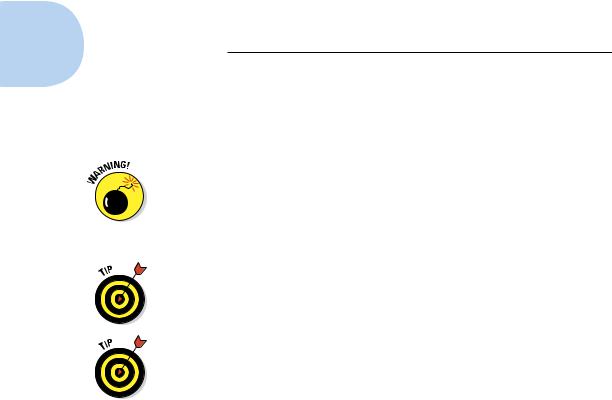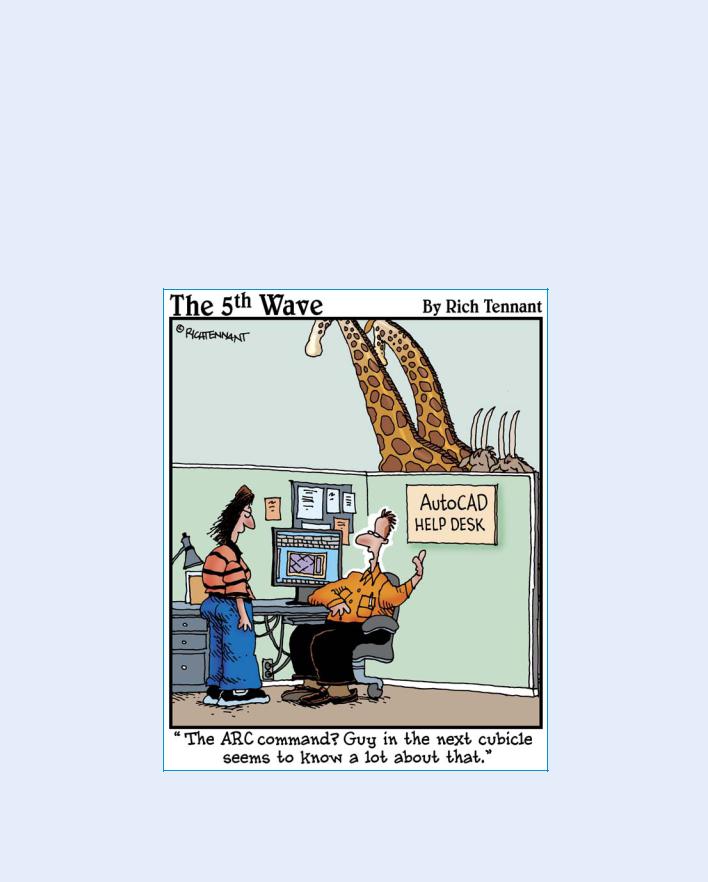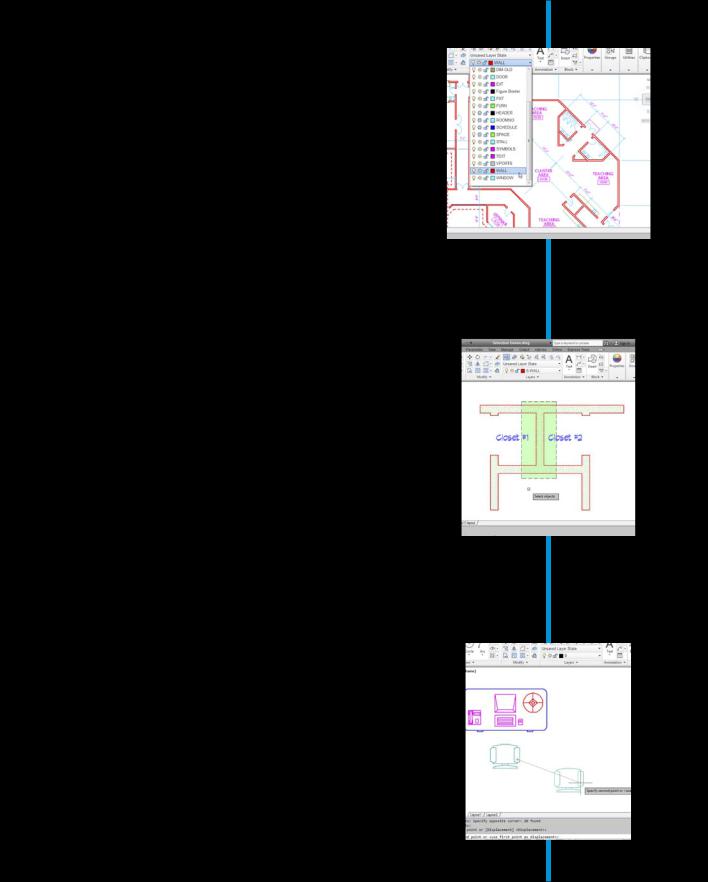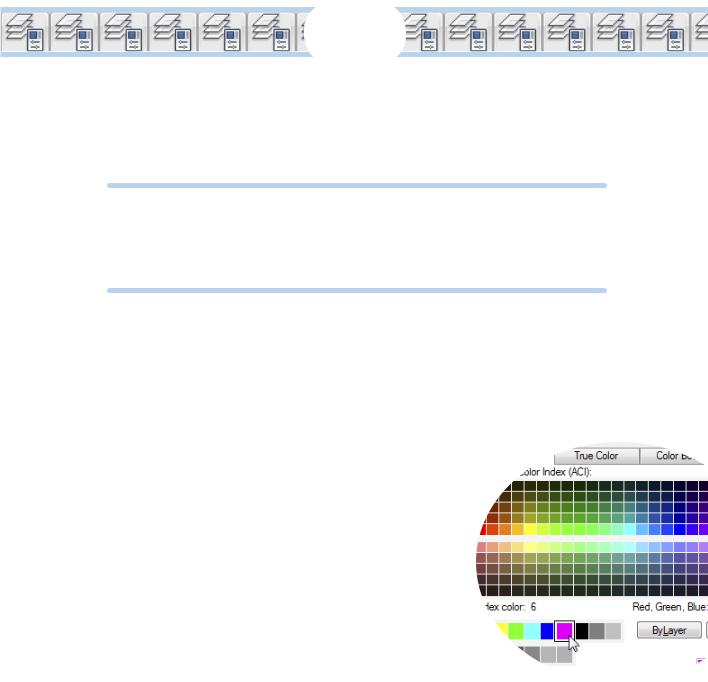
- •About the Authors
- •Dedication
- •Authors’ Acknowledgments
- •Table of Contents
- •Introduction
- •What’s Not (And What Is) in This Book
- •Mac attack!
- •Who Do We Think You Are?
- •How This Book Is Organized
- •Part I: AutoCAD 101
- •Part II: Let There Be Lines
- •Part III: If Drawings Could Talk
- •Part IV: Advancing with AutoCAD
- •Part V: On a 3D Spree
- •Part VI: The Part of Tens
- •But wait . . . there’s more!
- •Icons Used in This Book
- •A Few Conventions — Just in Case
- •Commanding from the keyboard
- •Tying things up with the Ribbon
- •Where to Go from Here
- •Why AutoCAD?
- •The Importance of Being DWG
- •Seeing the LT
- •Checking System Requirements
- •Suddenly, It’s 2013!
- •AutoCAD Does Windows (And Office)
- •And They’re Off: AutoCAD’s Opening Screens
- •Running with Ribbons
- •Getting with the Program
- •Looking for Mr. Status Bar
- •Let your fingers do the talking: The command window
- •The key(board) to AutoCAD success
- •Keeping tabs on palettes
- •Down the main stretch: The drawing area
- •Fun with F1
- •A Simple Setup
- •Drawing a (Base) Plate
- •Drawing rectangles on the right layers
- •Circling your plate
- •Nuts to you
- •Getting a Closer Look with Zoom and Pan
- •Modifying to Make It Merrier
- •Hip-hip-array!
- •Stretching out
- •Crossing your hatches
- •Following the Plot
- •A Setup Roadmap
- •Choosing your units
- •Weighing up your scales
- •Thinking annotatively
- •Thinking about paper
- •Defending your border
- •A Template for Success
- •Making the Most of Model Space
- •Setting your units
- •Making the drawing area snap-py (and grid-dy)
- •Setting linetype and dimension scales
- •Entering drawing properties
- •Making Templates Your Own
- •Setting Up a Layout in Paper Space
- •Will that be tabs or buttons?
- •View layouts Quick(View)ly
- •Creating a layout
- •Copying and changing layouts
- •Lost in paper space
- •Spaced out
- •A view(port) for drawing in
- •About Paper Space Layouts and Plotting
- •Managing Your Properties
- •Layer one on me!
- •Accumulating properties
- •Creating new layers
- •Manipulating layers
- •Using Named Objects
- •Using AutoCAD DesignCenter
- •Copying layers between drawings
- •Controlling Your Precision
- •Keyboard capers: Coordinate input
- •Understanding AutoCAD’s coordinate systems
- •Grab an object and make it snappy
- •Other Practical Precision Procedures
- •Introducing the AutoCAD Drawing Commands
- •The Straight and Narrow: Lines, Polylines, and Polygons
- •Toeing the line
- •Connecting the lines with polyline
- •Squaring off with rectangles
- •Choosing your sides with polygon
- •(Throwing) Curves
- •Going full circle
- •Arc-y-ology
- •Solar ellipses
- •Splines: The sketchy, sinuous curves
- •Donuts: The circles with a difference
- •Revision clouds on the horizon
- •Scoring Points
- •Commanding and Selecting
- •Command-first editing
- •Selection-first editing
- •Direct object manipulation
- •Choosing an editing style
- •Grab It
- •One-by-one selection
- •Selection boxes left and right
- •Perfecting Selecting
- •AutoCAD Groupies
- •Object Selection: Now You See It . . .
- •Get a Grip
- •About grips
- •A gripping example
- •Move it!
- •Copy, or a kinder, gentler Move
- •A warm-up stretch
- •Your AutoCAD Toolkit
- •The Big Three: Move, Copy, and Stretch
- •Base points and displacements
- •Move
- •Copy
- •Copy between drawings
- •Stretch
- •More Manipulations
- •Mirror
- •Rotate
- •Scale
- •Array
- •Offset
- •Slicing, Dicing, and Splicing
- •Trim and Extend
- •Break
- •Fillet and Chamfer and Blend
- •Join
- •When Editing Goes Bad
- •Zoom and Pan with Glass and Hand
- •The wheel deal
- •Navigating your drawing
- •Controlling your cube
- •Time to zoom
- •A View by Any Other Name . . .
- •Looking Around in Layout Land
- •Degenerating and Regenerating
- •Getting Ready to Write
- •Simply stylish text
- •Taking your text to new heights
- •One line or two?
- •Your text will be justified
- •Using the Same Old Line
- •Turning On Your Annotative Objects
- •Saying More in Multiline Text
- •Making it with Mtext
- •It slices; it dices . . .
- •Doing a number on your Mtext lists
- •Line up in columns — now!
- •Modifying Mtext
- •Gather Round the Tables
- •Tables have style, too
- •Creating and editing tables
- •Take Me to Your Leader
- •Electing a leader
- •Multi options for multileaders
- •How Do You Measure Up?
- •A Field Guide to Dimensions
- •The lazy drafter jumps over to the quick dimension commands
- •Dimension associativity
- •Where, oh where, do my dimensions go?
- •The Latest Styles in Dimensioning
- •Creating and managing dimension styles
- •Let’s get stylish!
- •Adjusting style settings
- •Size Matters
- •Details at other scales
- •Editing Dimensions
- •Editing dimension geometry
- •Editing dimension text
- •Controlling and editing dimension associativity
- •Batten Down the Hatches!
- •Don’t Count Your Hatches. . .
- •Size Matters!
- •We can do this the hard way. . .
- •. . . or we can do this the easy way
- •Annotative versus non-annotative
- •Pushing the Boundary (Of) Hatch
- •Your hatching has no style!
- •Hatch from scratch
- •Editing Hatch Objects
- •You Say Printing, We Say Plotting
- •The Plot Quickens
- •Plotting success in 16 steps
- •Get with the system
- •Configure it out
- •Preview one, two
- •Instead of fit, scale it
- •Plotting the Layout of the Land
- •Plotting Lineweights and Colors
- •Plotting with style
- •Plotting through thick and thin
- •Plotting in color
- •It’s a (Page) Setup!
- •Continuing the Plot Dialog
- •The Plot Sickens
- •Rocking with Blocks
- •Creating Block Definitions
- •Inserting Blocks
- •Attributes: Fill-in-the-Blank Blocks
- •Creating attribute definitions
- •Defining blocks that contain attribute definitions
- •Inserting blocks that contain attribute definitions
- •Edit attribute values
- •Extracting data
- •Exploding Blocks
- •Purging Unused Block Definitions
- •Arraying Associatively
- •Comparing the old and new ARRAY commands
- •Hip, hip, array!
- •Associatively editing
- •Going External
- •Becoming attached to your xrefs
- •Layer-palooza
- •Creating and editing an external reference file
- •Forging an xref path
- •Managing xrefs
- •Blocks, Xrefs, and Drawing Organization
- •Mastering the Raster
- •Attaching a raster image
- •Maintaining your image
- •Theme and Variations: Dynamic Blocks
- •Lights! Parameters!! Actions!!!
- •Manipulating dynamic blocks
- •Maintaining Design Intent
- •Defining terms
- •Forget about drawing with precision!
- •Constrain yourself
- •Understanding Geometric Constraints
- •Applying a little more constraint
- •AutoConstrain yourself!
- •Understanding Dimensional Constraints
- •Practice a little constraint
- •Making your drawing even smarter
- •Using the Parameters Manager
- •Dimensions or constraints — have it both ways!
- •The Internet and AutoCAD: An Overview
- •You send me
- •Send it with eTransmit
- •Rapid eTransmit
- •Bad reception?
- •Help from the Reference Manager
- •Design Web Format — Not Just for the Web
- •All about DWF and DWFx
- •Autodesk Design Review 2013
- •The Drawing Protection Racket
- •Autodesk Weather Forecast: Increasing Cloud
- •Working Solidly in the Cloud
- •Free AutoCAD!
- •Going once, going twice, going 123D
- •Your head planted firmly in the cloud
- •The pros
- •The cons
- •Cloudy with a shower of DWGs
- •AutoCAD 2013 cloud connectivity
- •Tomorrow’s Forecast
- •Understanding 3D Digital Models
- •Tools of the Trade
- •Warp speed ahead
- •Entering the third dimension
- •Untying the Ribbon and opening some palettes
- •Modeling from Above
- •Using 3D coordinate input
- •Using point filters
- •Object snaps and object snap tracking
- •Changing Planes
- •Displaying the UCS icon
- •Adjusting the UCS
- •Navigating the 3D Waters
- •Orbit à go-go
- •Taking a spin around the cube
- •Grabbing the SteeringWheels
- •Visualizing 3D Objects
- •Getting Your 3D Bearings
- •Creating a better 3D template
- •Seeing the world from new viewpoints
- •From Drawing to Modeling in 3D
- •Drawing basic 3D objects
- •Gaining a solid foundation
- •Drawing solid primitives
- •Adding the Third Dimension to 2D Objects
- •Creating 3D objects from 2D drawings
- •Modifying 3D Objects
- •Selecting subobjects
- •Working with gizmos
- •More 3D variants of 2D commands
- •Editing solids
- •Get the 2D Out of Here!
- •A different point of view
- •But wait! There’s more!
- •But wait! There’s less!
- •Do You See What I See?
- •Visualizing the Digital World
- •Adding Lighting
- •Default lighting
- •User-defined lights
- •Sunlight
- •Creating and Applying Materials
- •Defining a Background
- •Rendering a 3D Model
- •Autodesk Feedback Community
- •Autodesk Discussion Groups
- •Autodesk’s Own Bloggers
- •Autodesk University
- •The Autodesk Channel on YouTube
- •The World Wide (CAD) Web
- •Your Local ATC
- •Your Local User Group
- •AUGI
- •Books
- •Price
- •3D Abilities
- •Customization Options
- •Network Licensing
- •Express Tools
- •Parametrics
- •Standards Checking
- •Data Extraction
- •MLINE versus DLINE
- •Profiles
- •Reference Manager
- •And The Good News Is . . .
- •APERTURE
- •DIMASSOC
- •MENUBAR
- •MIRRTEXT
- •OSNAPZ
- •PICKBOX
- •REMEMBERFOLDERS
- •ROLLOVERTIPS
- •TOOLTIPS
- •VISRETAIN
- •And the Bonus Round
- •Index

Chapter 5: Planning for Paper 121
Reread that last sentence and then think about how often you have to pan and zoom in your drawing. If you zoom inside a viewport whose scale you’ve set — kaboom! — you just blew the scale off the map. Luckily, you can prevent yourself or anyone else from inadvertently destroying your beautifully arranged and scaled viewport by completing the final steps of viewport setup:
10.Make sure that you’re in paper space (check the UCS icon or move the crosshairs).
11.Select the boundary of the viewport whose arrangement you want to protect.
With the viewport selected, the Viewport Scale button reappears with its selectable list of scales, and right beside it is another button with a yellow unlocked padlock icon. As its tooltip indicates, its function is to lock and unlock viewports.
12.Click the Lock/Unlock Viewport button to lock the viewport scale.
The yellow unlocked padlock changes to a blue locked padlock, and the Viewport Scale button now becomes unselectable. Locking the display sets AutoCAD up for some nifty zooming . . . if you’re in paper space, a normal zoom is executed. If you’re in model space inside a viewport, a normal zoom would wreck the scale, so when you try to zoom, AutoCAD near-instantaneously switches to paper space, zooms you in, and then switches back to model space. Sheer prestidigitation!
Sometimes the perfect viewport arrangement requires that a smaller viewport be completely surrounded by a larger one. Easy enough to create, yes, and easy to select — as long as you’re in paper space.
However, if you’re in model space and you want to click from one viewport to the next to make it current, it’s impossible to make model space current in a completely surrounded viewport by clicking inside it. Let your fingers come to the rescue: The Ctrl+R key combination cycles through model space in all drawing viewports, even if they’re completely surrounded by other viewports.
And there you have your 12-step program to layout bliss! All that setup had a purpose, of course: to enable you to print perfect paper plots (or plot-perfect paper prints, if you prefer to see it that way). We cover plotting in depth in Chapter 16, but a short introductory word here might be useful.
About Paper Space Layouts and Plotting
As this chapter describes, you can use AutoCAD’s paper space feature to compose one or more layouts for plotting your drawing in particular ways. Each layout lives on a separate tab, which you click at the bottom of the drawing area — or in a secret hiding place if you’ve hidden the Model and Layout tabs. AutoCAD saves plot settings (plot device, paper size, plot scale, and so on) separately for each of the layouts, as well as model space.
www.it-ebooks.info

122 Part I: AutoCAD 101
Whether to plot model space or a layout in a drawing depends entirely on how the drawing was set up. If you or someone else went through a layoutsetup procedure similar to the one in this chapter, you probably should plot the layout. If not, plot model space.
Viewport boundaries will print if you don’t pay attention to where you create them. What that means is that each drawing view has a nice rectangular border around it. Nice, but a definite no-no in every drafting office. In Chapter 6, we introduce you to object properties, including probably the most important one, layers. You can define a layer so that objects on it do not plot, and that’s where you should create your viewports.
If you don’t have any paper space drawings handy, you can use one of the AutoCAD sample drawings. Refer to the tip near the beginning of the “Setting Up a Layout in Paper Space” section, earlier in the chapter, for where to find the sample drawings.
Some different ways of plotting the same model can be handled in a single paper space layout with different page setups. See Chapter 16 for more details. If your projects require lots of drawings, you can parlay layouts into sheet sets — a feature that makes for more sophisticated creation, management, plotting, and electronic transfer of multisheet drawing sets.
www.it-ebooks.info

Part II
Let There Be Lines
www.it-ebooks.info

Lines, circles, and other elements of geometry make up the heart of your drawing. AutoCAD
offers many different drawing commands, many ways to use them to draw objects precisely, and many properties for controlling the on-screen and plotted appearance of objects. After you draw your geometry, you’ll probably spend at least as much time editing it as your design and drawings evolve. And in the process, you’ll need to zoom in and out and pan all around to see how the entire drawing is coming together.
Drawing geometry, editing it, and changing the displayed view are the foundation of the drawing process; this part shows you how to make that foundation solid.
www.it-ebooks.info

6
Manage Your Properties
In This Chapter
Managing layers
Managing object properties like color, linetype, and lineweight
Copying layers and other named objects between drawings with DesignCenter
CAD programs are different from other drawing programs. You have to pay attention to little details, like object properties and the precision of the points that you specify when you draw and edit objects. If you ignore
these details and just start drawing, you’ll end up with a mess of sloppy geometry that’s hard to edit, view, and plot.
This chapter introduces you to object properties, one set of AutoCAD tools and techniques that helps you prevent CAD messes. Chapter 7
explains the most important precision drawing techniques that you need to observe to create usable AutoCAD drawings. The information in these two chapters is essential
to understand before you start drawing and editing objects, procedures that we describe in Chapters 8 through 11.
When you first start using AutoCAD, one of its most overwhelming aspects is the number of property settings and precision controls that you need to pay attention to — even when you draw a simple line. Unlike many other programs, it’s not enough to draw a line in a more-or-less-adequate location and then slap some color on it. But all those settings and
controls can inspire the feeling that you have to learn
how to drive a Formula 1 car to make a trip down the street. (The advantage is that after you are comfortable in the driver’s seat, AutoCAD takes you on the long-haul trips and gets you there faster.)
www.it-ebooks.info
